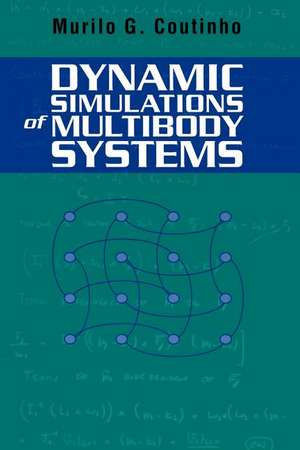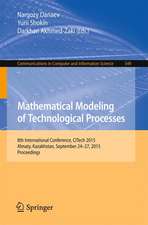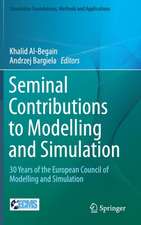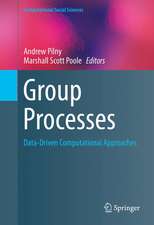Dynamic Simulations of Multibody Systems
Autor Murilo G. Coutinhoen Limba Engleză Paperback – 9 oct 2011
Preț: 929.38 lei
Preț vechi: 1161.72 lei
-20% Nou
Puncte Express: 1394
Preț estimativ în valută:
177.86€ • 185.00$ • 146.83£
177.86€ • 185.00$ • 146.83£
Carte tipărită la comandă
Livrare economică 14-28 aprilie
Preluare comenzi: 021 569.72.76
Specificații
ISBN-13: 9781441929020
ISBN-10: 1441929029
Pagini: 396
Ilustrații: XV, 379 p.
Dimensiuni: 155 x 235 x 21 mm
Greutate: 0.55 kg
Ediția:2001
Editura: Springer
Colecția Springer
Locul publicării:New York, NY, United States
ISBN-10: 1441929029
Pagini: 396
Ilustrații: XV, 379 p.
Dimensiuni: 155 x 235 x 21 mm
Greutate: 0.55 kg
Ediția:2001
Editura: Springer
Colecția Springer
Locul publicării:New York, NY, United States
Public țintă
Professional/practitionerCuprins
1 Computational Dynamics.- 2 Hierarchical Representation of 3D Polyhedra.- 3 Particle Systems.- 4 Rigid-Body Systems.- 5 Articulated Rigid-Body Systems.- A Useful 3D Geometric Constructions.- A.1 Introduction.- A.2 Projection of a Point on a Line.- A.3 Projection of a Point on a Plane.- A.4 Intersection of a Line Segment and a Plane.- A.5 Closest Point between a Line and a Line Segment.- A.6 Computing the Collision- or Contact-Local Frame from the Collision- or Contact-Normal Vector.- A.7 Representing Cross-Products as Matrix-Vector multiplication.- A.8 Suggested Readings.- B Numerical Solution of Ordinary Differential Equations of Motion.- B.1 Introduction.- B.2 Euler Method.- B.2.1 Explicit Euler.- B.2.2 Implicit Euler.- B.3 Runge-Kutta Method.- B.3.1 Second-Order Runge-Kutta Method.- B.3.2 Forth-Order Runge-Kutta Method.- B.4 Using Adaptive Time-Step Sizes to Speed Computations.- B.5 Suggested Readings.- C Quaternions.- C.1 Introduction.- C.2 Basic Quaternion Operations.- C.2.1 Addition.- C.2.2 Dot product.- C.2.3 Multiplication.- C.2.4 Conjugate.- C.2.5 Module.- C.2.6 Inverse.- C.3 Unit Quaternions.- C.4 Rotation-Matrix Representation Using Unit Quaternions.- C.5 Advantages of Using Unit Quaternions.- C.6 Suggested Readings.- D Rigid-Body Mass Properties.- D.1 Introduction.- D.2 Mirtich’s Algorithm.- D.2.1 Volume-Integral to Surface-Integral Reduction..- D.2.2 Surface-Integral to Projected-Surface-Integral Reduction.- D.2.3 Projected-Surface-Integral to Line-Integral Reduction.- D.2.4 Computing the Line Integrals from the Vertex Coordinates.- D.3 Suggested Readings.- E Useful Time Derivatives.- E.1 Introduction.- E.2 Computing the Time Derivative of a Vector Attached to a Rigid Body.- E.3 Computing the Time Derivative of a Contact-Normal Vector.- E.3.1Particle-Particle Contact.- E.3.2 Rigid Body-Rigid Body Contact.- E.4 Computing the Time Derivative of the Tangent Plane.- E.5 Computing the Time Derivative of a Rotation Matrix.- E.6 Computing the Time Derivative of a Unit Quaternion.- E.7 Suggested Readings.- F Convex Decomposition of 3D Polyhedra.- F.1 Introduction.- F.2 Joe’s Algorithm.- F.2.1 Determining Candidate Cut Planes.- F.2.2 Computing the Cut Face Associated with a Cut Plane.- F.2.3 Termination Conditions.- F.3 Suggested Readings.- G The Linear-Complementarity Problem.- G.1 Introduction.- G.2 Dantzig’s Algorithm: The Frictionless Case.- G.2.1 Termination Conditions.- G.3 Baraff’s Algorithm: Coping with Friction.- G.3.1 Static-Friction Conditions.- G.3.2 Dynamic Friction.- G.3.3 Termination Conditions.- G.4 Suggested Readings.- H Software Implementation.- References.
Recenzii
From the reviews:
"This is a monograph intended to provide its readers with a comprehensive introduction to the simulation and animation of multibody system dynamics. Both theoretical and applied concepts are discussed. The book is written for the designers of software to represent the kinematics and dynamics of systems of rigid bodies. … The book contains a vast store of information on computer graphics and the associated procedures." (Ronald L. Huston, Zentralblatt MATH, Vol. 976, 2002)
"This is a monograph intended to provide its readers with a comprehensive introduction to the simulation and animation of multibody system dynamics. Both theoretical and applied concepts are discussed. The book is written for the designers of software to represent the kinematics and dynamics of systems of rigid bodies. … The book contains a vast store of information on computer graphics and the associated procedures." (Ronald L. Huston, Zentralblatt MATH, Vol. 976, 2002)











